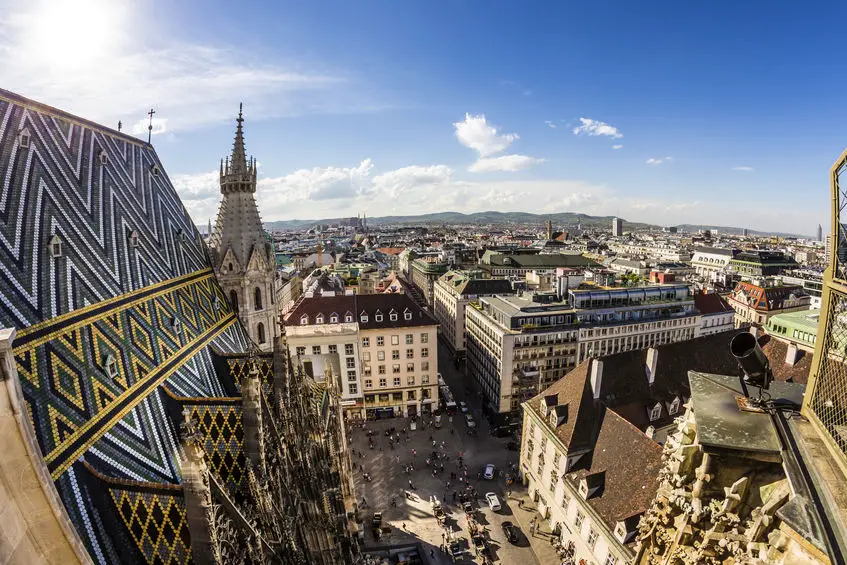OUR AUSTRIA TRAVEL GUIDE
When most people think of Austria, they think of rolling hills, skiing, Christmas markets, and The Sound of Music. And while the country does have all of this, it also has so much more!
For music lovers, it’s the home of Mozart. For foodies, it’s home to the Wienerschnitzel. For outdoor lovers, you can paraglide, raft, and hike. No matter what your love is, Austria likely has something just for you.
The minute you arrive, you the country’s charming villages will take you by surprise and have you feeling like you stepped into a Disney fairytale.


LANGUAGE
German is the official language spoken by 98% of the population. There are distinct differences between the many regional dialects, and also a wide variation in the ‘standard’ Hochdeutsch spoken from region to region

CURRENCY
The official currency of Austria is the Euro (EUR). 1£ is equivalent to just over 1 Euro.
To get the best exchange rate in Austria, it’s wise to use your credit card whenever you get the chance. There’s typically no service charge and are widely accepted throughout the country. If you need some Euros, you will find that ATMs are very prevalent in Austria, even in smaller towns. They are also likely linked to your bank at home so you shouldn’t run into any issues.

Electric Sockets
The standard voltage in Austria is 230 V, and the standard frequency is 50 Hz. The power outlets take type F outlets, so two-prong round and sometimes three-prong round. To avoid the hassle of having to buy new adaptors for everywhere you go, we recommend picking up a Universal Travel Adaptor before you leave

Visa
Austria permits a 90 days Visa-free travel to all EU citizens, including those not in the Schengen zone and 90 days Visa-free travel to those approved by the Schengen scheme including most of the Americas, Israel, and Australia.
You must always carry your passport with you in Austria as it is a legal requirement to have photo ID; Austrian citizens carry national ID cards. However, with that being said, we never were asked for our passports apart from checking into hotels.

Safety
Austria is a very safe country. Austria’s geopolitical position doesn’t put it at risk of terror and its high standard of living means crime is low and equality is high. Visitors will generally have no trouble walking around at night in cities.
The most dangerous crimes that affect tourists in Austria are pickpocketing and petty theft. Pickpockets occasionally operate on public transport and at major tourist sights. But as long as you practice common sense and take precautions, you won’t have any problems during your visit. Just keep your valuables out of sight.
Winter sports can be dangerous and you might get injured on the slopes. So always stay safe.
Even if you aren’t planning to go skiing, we still recommended that you get Travel Insurance. Personally, we would never leave without booking some sort of travel insurance beforehand. We recommend World Nomads as they cover you on a large variety of activities, from snorkeling to hiking. If you are looking for something more short-term, Safety Wings is a good alternative, as they have insurance plans that can be renewed on a monthly basis.

BUDGET
Austria is an expensive country to travel around, which is why it is often missed off the typical Europe travel route.
Saying that though, it is possible to travel here for approximately 90 Euro per day if you stay in hostels, cook most of your meals, and use local transport only when necessary. The average traveller can expect to spend about 165 Euros a day.
Accommodation in Austria can be quite expensive. A room in a budget hotel, including a light breakfast, might only set you back 50 Euros a night. But staying in a luxury hotel will cost you at least 200 Euros a night. Restaurant’s in Austria aren’t cheap either and if you are planning a trip to Vienna, expect to pay an entrance fee for most attractions
However, the entire experience is 100% worth it as it is one of the most amazing places we have been to in Europe
WHERE TO GO IN AUSTRIA
Are you travelling to Austria for the first time or returning for more? We hope to simplify your Austrian trip and help you chose where to go, how long to stay there and what to do once you have arrived. We research every destination we visit in-depth and have been to Austria ourselves. We have travelled to various areas in Austria and have created travel guides for all the places we visited. Each destination guide also includes a detailed tried and tested travel itinerary.
Vienna is the capital and largest city of Austria, located in the eastern part of the country. It is known for its rich history and culture, stunning architecture, world-class museums and galleries, and vibrant music scene. Vienna is also famous for its coffee houses, delicious pastries, and the beautiful Danube river which runs through the city.
Salzburg is a picturesque city in western Austria, known for its stunning baroque architecture, beautiful gardens, and historic old town. The birthplace of Mozart, Salzburg is a hub for classical music and home to numerous music festivals throughout the year. Visitors can also enjoy traditional cuisine, charming cafes, and stunning mountain views.
Innsbruck is a charming city located in the western part of Austria, nestled in the heart of the Alps. Known for its breathtaking mountain views, Innsbruck offers visitors a mix of outdoor activities, cultural attractions, and historic architecture. Highlights include the Golden Roof, the Alpine Zoo, and the Bergisel Ski Jump.
Hallstatt is a small lakeside village in the Salzkammergut region of Austria, known for its stunning natural beauty and rich history. Visitors can enjoy a range of outdoor activities, including hiking and boating, as well as exploring the village’s unique salt mining heritage. The village is a UNESCO World Heritage site and a popular destination for tourists.
Graz is a vibrant city located in southeastern Austria, known for its medieval old town, modern architecture, and lively cultural scene. Visitors can explore the historic landmarks, including the Schlossberg and Graz Cathedral, or take in the contemporary art and design scene. Graz is also a culinary hub, with numerous restaurants and cafes offering traditional and international cuisine.
Linz is a modern city in northern Austria, situated along the banks of the Danube river. Known for its innovative architecture and vibrant cultural scene, Linz is home to numerous museums, galleries, and festivals throughout the year. Visitors can also explore the historic landmarks, including the Linz Castle and the Old Town.
Klagenfurt is a charming city in southern Austria, known for its picturesque old town, stunning architecture, and scenic lakeside setting. Visitors can explore the historic landmarks, including the Lindwurm Fountain and the Klagenfurt Cathedral, or enjoy outdoor activities like swimming, boating, and cycling along the nearby Wörthersee lake.
OUR SUGGESTED ITINERARY FOR AUSTRIA
f you are planning a trip to Vienna, the capital of Austria, you might want to follow our five-day itinerary. We made sure that it included as many attractions as possible. This should alleviate any fear of missing out (FOMO). Here is the summary of our 5-day Vienna itinerary that we highly suggest you follow:
- DAY 1 – Stadtpark, Stephansdom Cafe Halweka, Mozarts House and House of Music
- DAY 2 – Albertina, Staatshalle, prunksaal, Schatzkammer Silberkammer, Sissimuseum and Kaiser Apaprtments
- DAY 3 – Schonbrunn and Vienna Zoo
- DAY 4 – Belvedere, Granny Cafe, Leopold Museum and Natural History Museum
- DAY 5 – Hofburg Gardens, Spanish riding School, Opera House, Naschmarkt and Karlskirche
We have written a very detailed post about the suggested 5 day Vienna itinerary with lots of information and travel tips.

TRANSPORTATION IN AUSTRIA

If you are travelling to Vienna you will most likely land at Vienna International Airport. If your destination is Innsbruck or the western end of the country, you can either transfer in Vienna for the one-hour flight to Innsbruck or fly instead to Munich, where airport shuttle buses will deposit you in Innsbruck in a little more than three hours. Domestic flights in Austria are expensive so it is best to travel around the country by ground transport.
Austria has a very efficient train system and there really is no reason to travel any other way. It is fast, comfortable, safe and always on time. It’s also the best way to enjoy the scenery. Trains are operated by the Austrian Federal Railways (Osterreichische Bundesbahnen, or OBB), which provides schedules, travel times, prices, and ticketing on its website. You can also use apps such as Rome 2 Rio to look up train connections.
The sleek, high-speed OBB Railjet, travels at 143 miles an hour and is one of Europe’s most luxurious and high-tech trains. It operates mostly within Austria but also connects the country’s major cities with neighboring destinations like Zurich, Budapest and Munich. There are also regular passenger trains that branch out to smaller towns, as well as sightseeing trains traveling famous scenic routes.
Because Austria is fairly small, train travel between cities is relatively short. From Vienna it’s about 2.5 hours to Salzburg (or less than two hours from Munich). The trip between Graz and Innsbruck takes about six hours.
Renting a car can be done from all airports (from our knowledge) and also in some bigger cities. If taking your own car from the UK then remember to check what the local laws are and make sure your car has been serviced. Remember they drive on the right in Austria.
BEST TIME OF YEAR TO VISIT AUSTRIA
Austria is a country with a wide variety of weather, so deciding on when to visit all depends on the activities you want to partake in. Overall, the best time to visit Austria is between April and May and September and October.
During the spring, you might be met with a rain shower or two. But it’s still a great time to wander around Vienna or Hofburg since the tourist season is just beginning. Come fall, and the mountains become covered in red and golden hues as the leaves change, making it one of the best times to hike.
Summer (June through August) is high season meaning both crowds and prices have doubled since spring. The heat can be felt, especially near the lakes, so it’s a wonderful time to take a dip. This is also the season of the Salzburg Festival, Vienna Festival, and the Rainbow Parade!
Winter in Austria can be quite chilly, but there’s something spectacular about walking around the Vienna Christmas market. If you’re an avid skier, this is the time to go skiing in the Austrian Alps before relaxing at one of the ski resorts.

ACCOMODATION IN AUSTRIA
Austria offers a variety of accommodation options for travellers, ranging from budget-friendly hostels to luxurious hotels and everything in between. If you’re traveling during peak season or holidays, it is best to book your accommodations in advance.
Many visitors choose to stay in the charming bed and breakfasts and guesthouses, which are often family-run and offer a more personal experience.
For those looking for a unique experience, Austria also has many traditional mountain huts and farm stays, where guests can experience the local culture and cuisine.
In cities like Vienna and Salzburg, there are numerous hotels and apartments for rent, ranging from affordable to high-end luxury. It’s always a good idea to book accommodation in advance, especially during peak travel season.
THINGS TO DO IN AUSTRIA
Austria, one of Europe’s most popular holiday destinations, attracts tourists year-round with places to visit in both summer and winter. In fact, with some of Europe’s finest skiing, winter is almost as busy as summer in the country’s spectacular mountain regions.
Visitors are drawn as much for the scenic beauty of this Alpine republic’s provinces as they are for splendid cities like Vienna (Wien), the historic capital, and beautiful Salzburg, birthplace of Wolfgang Amadeus Mozart.
One of Europe’s smallest countries, Austria is predominantly a nation of upland areas and high mountains, with the Eastern Alps occupying a good 60 percent of its territory. The River Danube flows for about 350 kilometers from west to east through the northern part of the country, adding to its allure as a tourist destination.
Some of the top things to do in Austria include:
- Visit Vienna and take in the beautiful architecture, museums, and coffee culture.
- Explore the stunning natural beauty of the Austrian Alps, including hiking, skiing, and snowboarding.
- Experience the charm of Salzburg, the birthplace of Mozart and the setting for the Sound of Music.
- Discover Austria’s rich history and culture by visiting historic sites like Schönbrunn Palace and the Hohensalzburg Fortress.
- Take a scenic drive through the picturesque countryside and charming villages.
- Enjoy outdoor activities like swimming in crystal-clear lakes, cycling along scenic paths, and exploring national parks.
- Attend cultural events like the Vienna Opera Ball or the Salzburg Festival.
- Visit the stunning UNESCO World Heritage Site of Hallstatt, a picturesque lakeside town.
- Experience the world-famous Christmas markets, held in cities throughout Austria during the holiday season.
Austria is home to many famous landmarks, including the stunning Schönbrunn Palace in Vienna, the Hohensalzburg Fortress in Salzburg, the historic Melk Abbey, the Golden Roof in Innsbruck, the charming village of Hallstatt, and the striking Swarovski Crystal Worlds. These landmarks showcase Austria’s rich cultural heritage and draw visitors from around the world.
Vienna, Austria’s capital city, offers a wealth of things to do, including visiting world-class museums and galleries, taking in the stunning baroque architecture, exploring the historic old town, enjoying traditional coffee and pastries, attending classical music concerts, and sampling delicious Austrian cuisine. Visitors can also take a scenic boat ride along the Danube river or visit the famous Vienna Zoo.
Vienna is a great base for day trips to nearby destinations, including the charming town of Bratislava in Slovakia, the stunning Wachau Valley, the historic city of Graz, the beautiful Vienna Woods, and the UNESCO World Heritage Site of Schönbrunn Palace. Visitors can also take a wine-tasting tour of the nearby vineyards or explore the quaint villages of the Danube Valley.
FAMILY TRAVEL IN AUSTRIA

Austria is frequently cited as one of the best places to live in Europe, and it is not difficult to see why. It is remarkably safe and clean and offers plenty of affordable culture, natural beauty as well as an efficient public transport system. This is also what make sit a great place to travel with kids.
Austria’s cities, such as Vienna and Salzburg are very family-friendly. there are loads of child-friendly museums in these cities, as well as plenty of parks if your kids get bored.
In summer you can go for a hike in the Austrian Alps and have a picnic in one of its many wildflower meadows. Or you could take a boat trip down the Danube River and marvel at all the Austrian fairy tale castle.
In winter most people travel to Austria to go skiing. Kids aged 3 and up can learn to ski in special kids ski camps, while you take on more advanced slopes. A lot of Austria’s ski resorts even have special Kinder hotels, which are specifically geared towards parents with babies or toddlers. Kinder hotels are a great option for families with younger children as they can supply all your baby and toddler requirements from food, to play areas to child care.
Another great thing to do with the kids in Austria in winter is to attend a Christmas market. Salzburg is said to have one of the best in Europe. Kids will love the lights, Christmas trees and entertainment.
FOOD TO TRY IN AUSTRIA
There are plenty of Austrian delicacies and traditional dishes that draw foodies and chefs here from different parts of the world.
Authentic Austrian cuisine is marked by rich flavours and dominated by meats and carb-dense foods like pastries and breads. Some of our favourite Austrian dishes include:
THE WIENER SCHNITZEL: a yummy fried delight and is served with a side of fried potatoes and sour cream and onions. You can find this dish right from street food stalls to high-end restaurants
KAISERSCHMARRN: basically fluffy shredded pancakes! The sweet dish if served as a dessert or even as a meal on its own. The pancakes are shredded into small pieces and topped with jams, sweet sauces, fruit compotes and caramelized dry fruits.
KNODEL: Counted among the best Austrian foods and Austrian snacks, the Knödel can be both sweet and savoury. The savoury Knödel are served as a side dish or even as meatballs in soup, while the best of sweet Knödel is a variety made up of plums.
TIROLER GROSTL: most commonly found in the Austrian Alps, this is comfort food at its best! It is actually a fairly simple dish, made up of pan-fried potatoes, chopped beef, or pork with lots of butter and onion. Often topped with a fried egg, it’s a must-try for someone fancying classic Austrian food

MOZARTKUGELN
Mozartkugeln are a popular Austrian confectionery made from a mixture of marzipan, nougat, and dark chocolate. Named after the famous composer Wolfgang Amadeus Mozart, who was born in Salzburg, these sweet treats are a popular souvenir for visitors to Austria and can be found in many shops and cafes throughout the country.
WHAT TO PACK FOR YOUR AUSTRIA TRIP

The weather in Austria varies greatly between different places, so be prepared for a range of temperatures as the mountains create a variety of local and regional microclimates.
Most of the country has a central European climate. With that in mind, make sure you bring lots of thin pieces of clothing that you can layer if you’re cold but that would also be suitable to wear alone for the warmer days.
Pack a pair of lightweight, durable and comfortable shoes. Known for its outside activities, including breathtaking hiking trails in the Austrian countryside, travellers eager to hike should pack a pair of hiking boots or trainers.
You should also consider packing a re-usable water bottle. City water foundations provide an excellent, clean and cheap water supply – they can be easily found in all major cities.
When traveling to Europe, it’s important to wear the right shoes for the cobblestone streets. Flat, comfortable shoes with a rubber sole are recommended to provide grip on the uneven surface. Avoid high heels or shoes with a smooth sole to prevent slipping. Ankle boots or sneakers are a good choice for both comfort and style.
When packing for a hiking trip, it’s important to bring the right gear to ensure a safe and enjoyable experience. Essential items include a sturdy pair of hiking boots or shoes, a backpack to carry gear, plenty of water and snacks, a map and compass or GPS device, and appropriate clothing for the weather. Other useful items include a first aid kit, sunscreen, insect repellent, and a headlamp or flashlight in case of low light conditions.
THE BEST GUIDE BOOKS FOR AUSTRIA
Planning a trip to Austria can be overwhelming with so many things to see and do. To make the most of your time and experience all that Japan has to offer, it’s essential to have a reliable source of information.
On this blog we try to cover as much information as we can and provide information based on our own experience travelling to Austria. Since we have now travelled to this beautiful country several times, we are able to cover quite a bit of ground.
While travel blogs can provide a wealth of information, they often cannot compare to the convenience and comprehensiveness of a good guidebook. Guidebooks offer detailed information about a country’s history, culture, attractions, and transportation systems, as well as maps, recommendations, and insider tips from experts. They can be easily carried around and referred to at any time, even when you don’t have access to the internet.
There are many guidebooks available for Austria, each with its own unique style and features. Below we have highlighted some of the best guidebooks for Austria, to help you plan your trip and get the most out of your visit to this amazing country.
TRAVEL PLANNING RESOURCES FOR AUSTRIA
PLANNING
For all travel resources click travel planning
FLIGHTS
Find the cheapest flights with Skyscanner
HOTEL
Find a good accommodation deal with Booking.com
ACTIVITIES
Book your activities in advance with GetYourGuide
INSURANCE
Protect your trip and your family with World Nomads